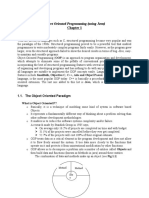Object-Oriented Programming
Uploaded by
Educative GlossObject-Oriented Programming
Uploaded by
Educative GlossObject-Oriented Programming
Object-Oriented Programming (OOP) is a programming paradigm based on the concept of
"objects," which can contain data and code: data in the form of fields (often referred to as
attributes or properties), and code in the form of procedures (often referred to as methods).
OOP aims to model real-world entities and their interactions within a program.
Key Concepts of Object-Oriented Programming:
1. Classes and Objects:
o Class: A class is a blueprint or template for creating objects. It defines a set of
attributes and methods that the objects created from the class will have.
o Object: An object is an instance of a class. It is created using the class and can
have its own unique values for the attributes defined in the class.
• Encapsulation:
• What It Is: Encapsulation is the concept of bundling the data (attributes) and
methods (functions) that operate on the data into a single unit, or class. It also
involves restricting access to some of the object's components, which is done using
access modifiers like private, protected, and public.
• Benefits: Encapsulation helps in protecting the data from unauthorized access and
modification. It also simplifies the interaction with the object by hiding complex
implementation details.
• Inheritance:
• What It Is: Inheritance allows a class (child or subclass) to inherit attributes and
methods from another class (parent or superclass). This promotes code reuse and
establishes a natural hierarchy between classes.
• Types of Inheritance:
o Single Inheritance: A class inherits from one superclass.
o Multiple Inheritance: A class inherits from more than one superclass.
o Multilevel Inheritance: A class inherits from a class that is already a child
class of another class.
Polymorphism:
• What It Is: Polymorphism allows objects of different classes to be treated as objects
of a common superclass. It is the ability of different objects to respond, each in its
own way, to identical messages (or method calls). Polymorphism is often
implemented using method overriding and method overloading.
• Method Overriding: When a subclass provides a specific implementation of a
method that is already defined in its superclass.
• Method Overloading: The ability to create multiple methods with the same name but
different parameters within the same class (this concept varies slightly across different
programming languages).
Abstraction:
• What It Is: Abstraction is the concept of hiding the complex implementation details
and showing only the essential features of an object. It allows focusing on what an
object does rather than how it does it.
• Abstract Classes: Abstract classes cannot be instantiated and often contain one or
more abstract methods (methods that have no implementation in the base class and
must be overridden in derived classes).
Advantages of Object-Oriented Programming:
• Modularity: Code is organized into classes, which makes it easier to manage and
modify.
• Reusability: Inheritance allows classes to reuse code from other classes, reducing
redundancy.
• Flexibility: Polymorphism allows objects to be treated as instances of their parent
class, which can simplify code and increase flexibility.
• Maintainability: Encapsulation and abstraction help in protecting the integrity of the
data and hiding complexity, making the code more maintainable.
Common OOP Languages:
• Python
• Java
• C++
• C#
• Ruby
• JavaScript (when used with frameworks like React or Angular)
You might also like
- Huawei HG8245 Backdoor and Remote AccessNo ratings yetHuawei HG8245 Backdoor and Remote Access2 pages
- Principles of Object-Oriented Programming PDFNo ratings yetPrinciples of Object-Oriented Programming PDF17 pages
- Object Oriented Programming (Model Questions Sol)No ratings yetObject Oriented Programming (Model Questions Sol)31 pages
- Introduction to Object-Oriented Programming (OOP) ^0 Its Core PillarsNo ratings yetIntroduction to Object-Oriented Programming (OOP) ^0 Its Core Pillars9 pages
- Updated Lecture Notes On Object Oriented Programming-1No ratings yetUpdated Lecture Notes On Object Oriented Programming-119 pages
- The Evolution of Object Oriented ProgrammingNo ratings yetThe Evolution of Object Oriented Programming7 pages
- Object Oriented Programming IB Computer ScienceNo ratings yetObject Oriented Programming IB Computer Science3 pages
- Object Oriented Programming (Using Java)No ratings yetObject Oriented Programming (Using Java)5 pages
- Chapter: 2 Principles of Object Oriented Programming Procedure-Oriented Programming: 1No ratings yetChapter: 2 Principles of Object Oriented Programming Procedure-Oriented Programming: 118 pages
- Object Oriented Programming Structure:: Oops ConceptsNo ratings yetObject Oriented Programming Structure:: Oops Concepts4 pages
- Christ College-Pune Department of Computer Science: Object Oriented Software EngineeringNo ratings yetChrist College-Pune Department of Computer Science: Object Oriented Software Engineering55 pages
- Object Oriented Programming Inheritance: Fundamentals and ApplicationsFrom EverandObject Oriented Programming Inheritance: Fundamentals and ApplicationsNo ratings yet
- Lexicon of Programming Terminology: Lexicon of Tech and Business, #17From EverandLexicon of Programming Terminology: Lexicon of Tech and Business, #175/5 (1)
- 3 Ways To Change A Computer's Mac Address in Windows - WikiHowNo ratings yet3 Ways To Change A Computer's Mac Address in Windows - WikiHow5 pages
- Price of FEA Software - Finite Element Analysis (FEA) Engineering - Eng-Tips PDFNo ratings yetPrice of FEA Software - Finite Element Analysis (FEA) Engineering - Eng-Tips PDF11 pages
- 8051 Microcontroller and Embedded Systems: A Six Week Training and Project Report OnNo ratings yet8051 Microcontroller and Embedded Systems: A Six Week Training and Project Report On50 pages
- Mixed Galerkin and Least-Squares FormulaNo ratings yetMixed Galerkin and Least-Squares Formula154 pages
- Computer Science Project Class Xi Vinay VenugopalNo ratings yetComputer Science Project Class Xi Vinay Venugopal36 pages
- "Eat Away Your Feelings": Beerbecue Beef Flank SteakNo ratings yet"Eat Away Your Feelings": Beerbecue Beef Flank Steak16 pages
- Adobe - Digital Signatures Workflow GuideNo ratings yetAdobe - Digital Signatures Workflow Guide114 pages

























































































